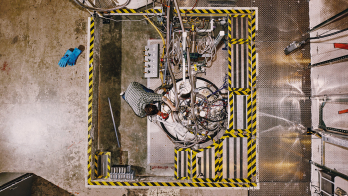
CERN’s radioactive ion-beam facility ISOLDE has stamped a new coin in its impressive collection. Long considered the domain of high-energy, in-flight rare-isotope facilities, chromium has now been produced at ISOLDE in prodigious quantities, thanks to a new resonant ionisation laser-ion source (RILIS) scheme. Together with the latest calculations based on chiral effective field theory, the result provides important guidance for improving theoretical approaches that bridge the gap between nuclear matter and the low-energy extension of quantum chromodynamics (QCD).
Certain configurations of protons and neutrons are more bound than others, revealing so-called magic numbers. Chromium has 24 protons, situating it squarely between magic calcium (with 20 protons) and nickel (with 28). Of particular interest to nuclear physics are isotopes with a large excess of neutrons.
The RILIS is a chemically selective ion source which relies on resonant excitation of atomic transitions using a tunable laser. In the new ISOLDE experiment, Maxime Mougeot of CSNSM/Université Paris-Saclay and collaborators used RILIS to venture 10 neutrons further on the nuclear chart to 63Cr. With a total of 39 neutrons, 63Cr lies exactly between the magic neutron numbers 28 and 50 and has a half-life of just 130 ms.
The masses of the newly forged chromium isotopes, as measured by ISOLDE’s precision Penning-trap mass spectrometer ISOLTRAP, offer insights into its shape and structure. Magic-number nuclides have filled orbitals that favour spherical shapes, but not so the chromium nuclides weighed by ISOLTRAP, which are deformed.Whereas in some areas of the nuclear chart deformation sets in very suddenly with the addition of a further neutron, the remarkably smooth neutron binding energies of chromium show that deformation sets in very gradually – contrary to previous conclusions.
The ISOLDE measurements were compared with different theoretical results, including a very first attempt by a new ab-initio approach called valence-space in-medium similarity renormalization group (VS-IMSRG). While several ab-initio approaches exist, until now they have been restricted to the near-spherical cases that have very few valence protons and neutrons. The latest VS-IMSRG results are the first for such open-shell nuclides.
“It turns out that the ab-initio VS-IMSRG, an interaction derived from chiral effective field theory which reduces QCD to its relevant degrees of freedom at the nuclear scale, failed to predict these results,” explains Mougeot. “So the recent chromium measurements are constructive and important for advancing this promising technique, which bridges the gap between first-principle calculations and the structure of nuclei at the extremes of the nuclear landscape.”
Further reading
M Mougeot et al. 2018 Phys. Rev. Lett. 120 232501.
T Day Goodacre et al. 2017 Spectroc. Acta B 129 58.







